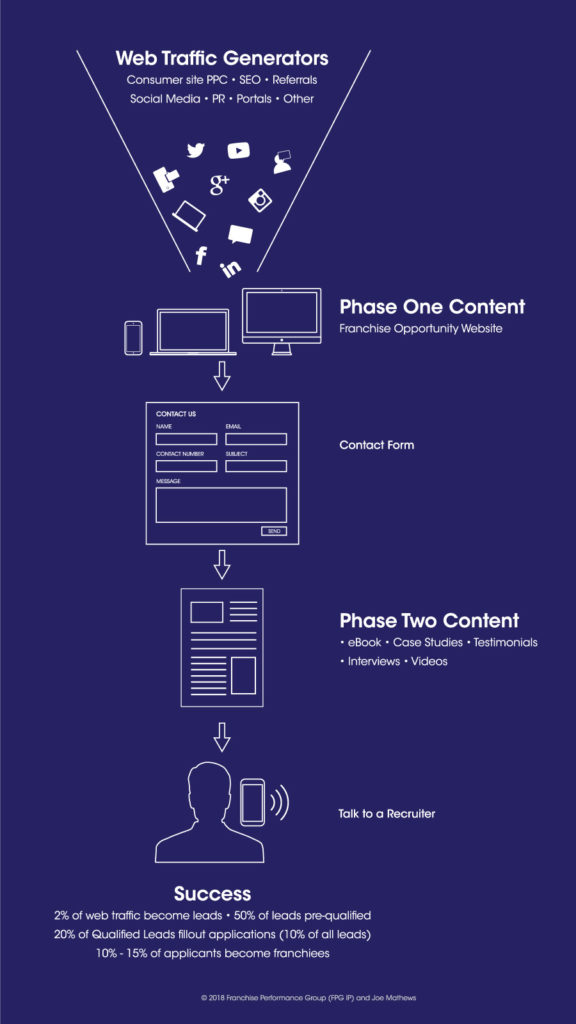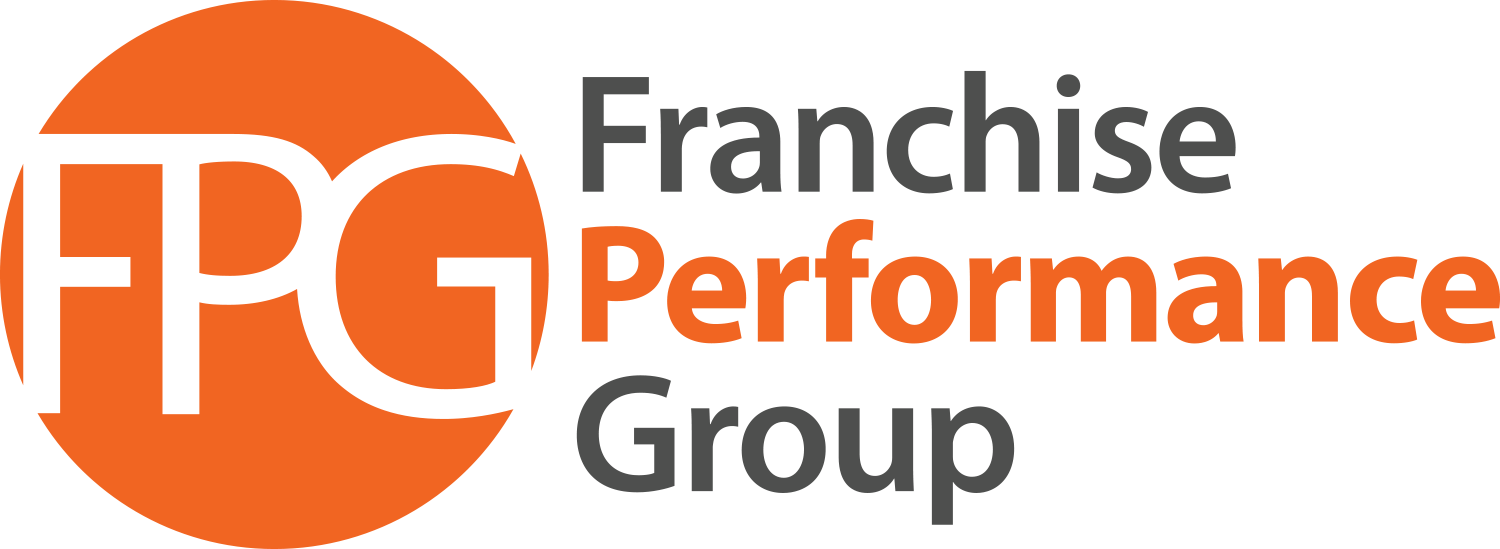
Shifts in Franchise Buyer Behavior Demands Franchisors Change Tactics
Eight years ago, about 80% of franchise candidates would research and analyze franchise opportunities from their desktop. At that time, FPG analysis showed the average buyer would spend 30-60 minutes on the franchise opportunity website and digest 15-30 pages of content prior to signing the contact form and engaging a franchisee recruiter.
Today, FPG’s research shows the average buyer spends almost 3 hours on a website and visits the site about 16 times. Click here to to view FPG research and analysis.
Mobile device usage is changing both the amount of content and the pace at which franchise candidates digest information during their self-directed research phase.
Three major franchise buyer behavior changes require franchisors to shift tactics:
- Mobile device user activity now accounts for up to 80% of lead flow and growing.
- Candidates’ desire for more self-directed research before engaging a representative.
- Despite placing a higher demand for transparent information prior to talking to the franchisor’s representative, candidates are filling out website contact forms earlier than in the past.
The candidates’ willingness to fill out forms earlier in their investigation may create a franchisor misperception that candidates therefore want less data. The absolute opposite is true. Candidates appear to be pacing their information-gathering differently than in the past. Many want the information and don’t plan on immediately engaging the franchisor’s recruiters.
These franchise buyer behavior changes require franchisors to adapt or redesign their franchise opportunity websites and lead-nurturing content strategy to stay current with buying behavior.
Franchise candidates are visiting the franchise opportunity website from their mobile devices and reviewing information at a high level. Then they fill out a simple contact form to request more information. Then they switch back and forth from a mobile device to a laptop or desktop, digesting information over multiple sessions rather than one continuous long session as in the past.
This requires franchisors to parcel out and pace their brand story differently.
Two Phases of Self-Directed Research
Franchise candidates essentially digest information in two separate and distinct phases:
- Information they require before they are willing to fill out a form
- Information they require before they are willing to speak to the franchisor’s recruiter
We will call these Phase One and Phase Two content streams. Here’s how the content streams work together to create higher engagement leading to more franchise sales.

Phase One content should be designed to encourage franchise candidates to opt in and fill out a contact form. For instance, sometimes FPG will hold back information on Item 19 earnings or territory availability, informing candidates that this information can be downloaded after they provide their contact information.
Phase Two content is offered to people who opt into the sales process: eBooks, automated marketing messages designed to deepen engagement — more privileged, in-depth, and specific content, driving candidates deeper into the sales funnel and breaking down any resistance the candidate has to speaking to the franchisor’s recruiter.
FPG’s Phase One Content
Phase One is materially presented in the franchise opportunity website, but more streamlined, better organized, easier to navigate, and created with a mobile-first design philosophy. FPG internal analysis shows franchise candidates visit approximately the same 10-12 pages arranged in a logical order. Simply, the franchise candidate wants common questions answered to their satisfaction before they sign a contact form. In general, these questions are:
- Who is the brand?
- What is the business?
- What is the consumer value proposition?
- What is the genius of the model? What makes the products or services unique (difficult to copy), defensible against competition (what are the barriers to entry), sustainable for the long haul, and valuable to the customer?
- What is the investment? Do I qualify? Am I willing to risk this amount?
- How much money can I make?*
- Is my desired territory/location available?*
- What is the industry like? (Overall trajectory, competitive analysis, opportunities, potential threats and disruption)
- How does the business model work? What does it take to win?
- What is the profile of a successful franchisee? Do I fit the profile?
- Who are the franchisees? Do I fit in?
- Who leads the brand? Does leadership have what it takes to compete and capture opportunity? What is the corporate culture like?
Additional site design best practices include:
- 10,000 words minimum (for SEO purposes and to provide candidates with meaningful answers to questions). To put this in perspective, a typical page in a Word document has about 300 words.
- Easy to navigate.
- Fast to load.
- Secure.
Here are two good examples of strong performing franchise opportunity websites FPG designed and manages. Both companies have experienced a significant resurgence in franchisee recruitment results, partly due to the impact of better website and lead nurturing content.
www.Poolwerxfranchising.com
Phase Two: Lead Nurturing Content
Franchise candidates should regard this information as privileged. This content is often available as a download or on a password-protected webpage that only qualified candidates can access. The franchisor reserves this proprietary content for franchise candidates who take the initiative to fill out a contact form and qualify for the opportunity. FPG finds that sites offering such privileged information drives franchisors’ “web traffic-to-lead” conversion rates higher than sites that don’t offer such content. For franchisors who adopt this two-phase content strategy, this means more engaged candidates for the same amount of website traffic, ultimately leading to a lower cost per deal.
Franchisors with strong Phase Two and other lead-nurturing content often close 20% or more of their franchise applicants. Those who don’t fall into the 8%-10% application-to-close conversion ratio.
Strong Content as a Labor Savings Device
Because more candidates are self-qualifying based on content franchisors provide, an intelligent and comprehensive content strategy creates higher early- and mid-stage pipeline efficiency, meaning less of the recruiter’s time is spent on nonresponsive leads in the front end of the pipeline. This in turn frees up the recruiters to spend more time on “money calls,” with qualified and motivated franchise applicants. For instance, one longtime FPG client reported successfully recruiting 20% of their applications in 2018, up from historically 10%-15%. Most franchisors struggle to recruit 10% of their qualified applications.
In the past, one franchisee recruiter could only handle 100-125 leads per month. With the right content strategy, an efficient and skilled recruiter can now handle 150 leads per month or more without needing a lead-screener. FPG believes there is a franchisee recruitment talent crisis in franchising right now. Strong content can compensate for a recruiter’s weak performance and perhaps save a franchisor from having to make a new hire.
Strong Content Compensates for Weak Recruiting
FPG has mystery shopped many franchisee recruiters over the years to provide professional development opportunities. More often than not, recruiters did not follow the franchisor’s recruitment process, choosing instead to shortcut the process in the hopes of getting candidates to Discovery Day. This often leaves qualified candidates confused or ignorant about the brand, the opportunity, and what it takes to win. Candidate confusion or misinformation often leads to fear, worry, or incorrect conclusions. This turns qualified candidates into dead leads.
After franchisors have spent perhaps hundred of thousands of dollars in advertising to locate qualified candidates, many of the candidates are not hearing the full brand story — to the detriment of both the franchisor and the candidate.
Content as a Risk Mitigator
If franchisors create a thorough and complete content strategy, then they can be certain every franchise candidate is fully informed about the business, the risks, and what it takes to win as a franchisee. Franchisors who rely heavily on conversations by franchise sales people to fully educate candidates about the nuances of their business run the risk of on-boarding a high number of unsuccessful and unhappy franchisees who will poison the culture, place a burden on the operations support team, and knock the franchisor off their strategic plan.
Projected ROI on Phase One and Phase Two Content
FPG designs Phase One websites and Phase Two content for a combined $30,000.
Franchisors generally see payback based in the form of increased franchise fee revenue within 180 days or less. When considering the high-margin flow-through to the bottom line on an incremental royalty stream, plus 6X to 15X increase in shareholder value on the percentage of royalties that flows through to the bottom line, franchisors will see a positive ROI on one new franchisee recruited.
Franchisors who do nothing will see a consistent erosion of deal flow and market share to the competitors who match their recruitment process to the franchise candidates’ buying process.
Is your content strategy old or inadequate? If you didn’t hit your objectives in 2020, don’t lose 2021. You need to act now.
